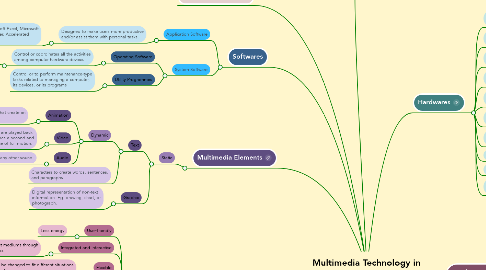
1. Computer-based techniques of text, images, audio, video, graphics, animation. Information can be represented, processed, stored, transmitted, produced and presented digitally (Shelly & Vermaat, Discovering Computers Fundamentals)
2. What is Multimedia?
3. Softwares
3.1. Application Software
3.1.1. Designed to make users more productive and/or assist them with personal tasks.
3.1.1.1. Microsoft Word, Microsoft Excel, Microsoft PowerPoint, Movie Maker, Accelerated Reader
3.2. System Software
3.2.1. Operating Software
3.2.1.1. Control or coordinates all the activities among computer hardware devices
3.2.1.1.1. Windows, Mac, Unix, Linux
3.2.2. Utility Programmes
3.2.2.1. Control or to perform maintenance-type tasks related to managing a computer, its devices, or its programs
4. Multimedia Elements
4.1. Static
4.1.1. Text
4.1.1.1. Dynamic
4.1.1.1.1. Animation
4.1.1.1.2. Video
4.1.1.1.3. Audio
4.1.1.2. Characters to create words, sentences, and paragraphs.
4.1.2. Graphic
4.1.2.1. Digital representation of non-text information. Eg: drawing, chart, or photograph.
5. Advantages in using Multimedia
5.1. User-friendly
5.1.1. Less energy
5.2. Integrated and interactive
5.2.1. Integration of different mediums through the digitization process
5.3. Flexible
5.3.1. Easily be changed to fit different situations and audiences
5.4. Wide variety of audiences
5.4.1. Young and adults
5.5. Creative industries
5.5.1. Creative way of information, ideas and news
5.6. Learning styles
5.6.1. Audio, visual, kinesthetic
5.7. Engaging & motivates
5.8. Saves time
5.9. Up to date
6. Challenges in Implementation
6.1. Technical problem
6.2. Incompatibility of technologies
6.3. Intersection of technology and pedagogy
6.4. Unprepared
7. The Future
7.1. Major impact on methods of teaching and learning
7.2. Rapid communication- real lifelong learning activity
7.3. Virtual campuses - increasing student access and participation
8. Hardwares
8.1. Monitor - primary device for displaying information
8.2. Tower – metal casing that holds all of computers components.
8.3. Keyboard – the primary device for entering information into the computer
8.4. Processor – sends and receives information, completes tasks.
8.5. RAM – makes things easier for the computer to access
8.6. ROM – small memory chip only used at start up
8.7. Mouse - the primary device for navigating and interacting with the computer
8.8. Central Processing Unit (CPU)
8.9. Hard Drive – stores data inside a computer
8.10. USB – connecting devices to a computer
9. Disadvantages in Using Multimedia
9.1. Overload information
9.1.1. too much information at once
9.2. Time consuming
9.2.1. takes time to compile and put the original draft together
9.3. Expensive
9.3.1. makes use of a wide range of resources
9.4. Memory storage
9.4.1. Large files; larger computer to store the files
9.5. Specific education, learning and practices
9.6. Violation of usage
9.6.1. Pornography, gambling, piracy
